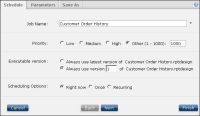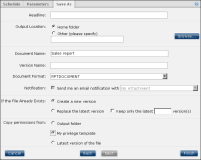How to schedule a file job
To schedule a file job using Categories view:
1 In Items You Can Run, navigate to the design or document file.
2 Choose Schedule.
Optionally, using Details, Icons, or List view, choose File➛Schedule. In Icons and List view, File menu appears when the cursor is over a file icon.
3 In Schedule, provide scheduling information, as shown in
Figure 3‑4.
Figure 3‑4 Scheduling a file job

Accept the default job name or type a new name. To distinguish multiple run schedules for the same report, assign a unique name for each job.

To set the job priority, select Low, Medium, or High, or select Other and type a priority value.

Select a scheduling option:

To schedule the report to run immediately, select Right now.

To generate the report once on a specified day and time, select Once. Type the date-and-time value, or choose the Calendar to select a date.

To repeat generating the report, select Recurring, as
Figure 3‑5 shows.
Figure 3‑5 Scheduling options
Select an interval, such as the first day of every month, and a time to run the report. Optionally, select a start and end date during which the run job repeats.
4 Choose Next. For a file requiring parameters, Parameters appears, as shown in
Figure 3‑6. Otherwise, Save As appears.
Figure 3‑6 Selecting parameters
5 Select or type values for required parameters. Use the Query by Example syntax when the parameter is an ad hoc parameter, as explained later in this section. Choose Next to specify output settings.
6 In Save As, provide the information necessary to save the scheduled file, as shown in
Figure 3‑7.
Figure 3‑7 Adding information to save a file job

In Headline, type a description of the file job. This description is included in any channel notifications and is saved with the job report.

In Output Location, select a location to save the document or select the Home folder location. Other locations are available by typing a new location, navigating to a new save location or by using a date-and-time expression, as explained later in this section.

In Document Name, accept the default or type a new name.

In Version Name, optionally type a unique version name. When scheduling a file job to run on a recurring basis, adding a date-and-time expression creates unique document, directory, or version names.
7 Select the document format to generate. Each output type has various conversion options, as shown in
Figure 3‑8. Additional conversion options appear, depending on the selected document format.
Figure 3‑8 Selecting output conversion options
8 Optionally, to receive an e‑mail notification when the file job runs, select Send me an e‑mail notification. Select the attachment format to attach a copy of the file job output to the e-mail notification. The user’s e‑mail address as configured from the Information Console’s user options is used to send the e‑mail. If the e‑mail notification option is not available, contact the administrator.
9 Specify a resolution if the file name already exists in the selected location. Select Create a new version to create a new version of the report and retain existing versions. Optionally, choose how many previous versions to retain by selecting Keep only the latest. Type the number of versions to keep.
10 Optionally, in Copy permissions from, choose Output folder or Latest version of the file.
Choose Finish. Confirmation of job submission appears, as
Figure 3‑9 shows.
Figure 3‑9 Confirming submission of a scheduled job




